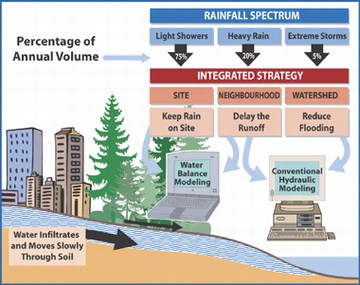Performance Targets for Rainwater Management
Founded on British Columbia case study experience, and published by the Province in 2002, Stormwater Planning: A Guidebook for British Columbia  formalized a science-based understanding to set performance targets for reducing rainwater runoff volumes and rates. These targets represent the synthesis of biological and hydrological understanding. For more information, please click here.
formalized a science-based understanding to set performance targets for reducing rainwater runoff volumes and rates. These targets represent the synthesis of biological and hydrological understanding. For more information, please click here.
The Guidebook formalized the Integrated Strategy for Managing the Complete Spectrum of Rainfall Events as the foundation for a “design with nature” approach to rainfall capture and runoff control. The key to implementing the strategy is that most of the annual rain volume falls as light showers. Although daily rainfall amounts range from light showers to heavy rain to extreme storms, only a handful of long duration downpours occur in any year and extreme events are rare.
Traditional single-purpose 'stormwater management' was reactive because it dealt only with the consequences of the handful of extreme storms that occurred infrequently; while ignoring the property and environmental impacts that resulted from the frequently occurring rainfalls. Rainwater management, on the other, is proactive in managing all the rainfall events that occur in a year.
Integrated Strategy for Managing the Rainfall Specturm
The graphic below illustrates the integrated strategy for protection of life, property and the environment that is being implemented throughout British Columbia as a result of publication of the Guidebook and development of the Water Balance Model for British Columbia as an extension of the Guidebook.

Because 'light showers' account for most of the annual rainfall volume, landscape-based solutions are effective in reducing both runoff volume and the number of occurrences in a year; as well as rates of runoff.
Posted December 2006

